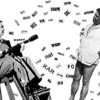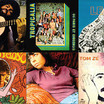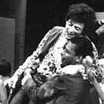Eubioticamente atraídos

tropicália agora!
Foreign views
TROPICÁLIA AGORA!
Gerald Marzorati, New York Time Magazine, 25 de abril de 1999
Like Lévi-Strauss, Byrne has done a good deal of fieldwork, and the composers and musicians he has been most passionately drawn to are those who emerged in the late 60´s from Brazil’s short-lived counterculture. They saw themselves as pop avant-gardist, and as part of a movement that also manifested itself in poetry, drama and visual art. They didn’t create a new musical style so much as a new approach to music-making, combining the ambitious album-oriented rock then making its way to them from England and the United States with Brazil’s various rhythm-thick musics and a variety of other ingredients, including difficult modernist poetry and weird found sounds. They wrote wildly prismatic lyrics about the ambivalence they felt concerning Brazil’s more and more Americanized, consumer-oriented culture and careful (and eventually not so careful) lyrics about the constraints of living under a military dictatorship. They ca1led the music they were making “Tropicália” and they created three-minute songs that had all the jagged jump-cuts, wised-up art-about- art references and sheer pop lyricism of a two-hour Godard movie.
“What drew me to it was the sophistication – the musical sophistication but also the sophistication they had about their situation globally,” Byrne told me. “What was ‘center’ what was ‘periphery’. This sense that Brazil was still this place tied up with our notions of the exotic, the ‘primitive’ – they were on to that, and in the music, they were combining all this stuff they were getting from us with other stuff and sort of throwing it back out there. Not in an angry way, but with irony and adventurousnes, and with all those great rhythms – which gives it its particular flavor.”
A number of Brazil’s greatest contemporary songwriters, including Caetano Veloso and Gilberto Gil, who went on to become huge stars in their country, began their careers at the center of Tropicália, but their music has taken a while to arrive in America, and not just because the songs are in Portuguese. Only with the advent here of an appropriate-and- cycle, combine-and-recombine esthetic could the Tropicalistas’ music – long with the music of younger Brazilians they’ve influenced – – finally be heard for what it is: radically ingenious pop.
Veloso, Gil and the others arrived at a different idea about rock. They not only liked the Beatles and Bob Dylan and Jimi Hendrix, whose albums were making their way to Sao Paulo – they also wanted use their music, use it to break Brazilian pop out of its nationalist confines or, as Veloso once put it, to help create “an immediate posture of ‘being in the world’ – we rejected the role of a third-world country living in the shadow of more developed countries.” In their approach, the Tropicalistas were drawing heavily on the thinking of Brazil’s modernist writers of the 20’s, principally “The Cannibalist Manifesto” of Oswald de Andrade, an antiestablishment poet. Andrade urged Brazilian artists to devour foreign art and information along with their national canon and daily papers and then to “regurgitate” it all, creating new forms of transcontinental bricolage that would inherently comment on Brazil’s place in the world. In today’s pop terms, it was a call for global sampling and mixing – and that’s pretty much what it amounted to in the music of Gil, Veloso and the rest, once they began plugging in electric guitars and experimenting with different sounds and various sorts of poetry- inspired lyrics.























